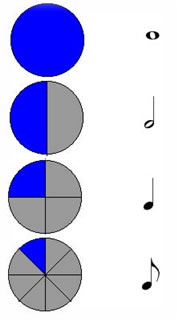Music theory. Time Signature and Durations
3. Time Signature and Durations
“It’s easy to play any musical instrument:
all you have to do is touch the right key at the
right time and the instrument will play itself.”
(J.S. Bach).
OK, now we know how pitches are notated and can play them. We only need to understand at what moment of time each sound has to be played. It’s easy!
The music essentially has grown from two kinds of activities: dancing and singing. Dancing is a series of moves or steps. From one foot to another, in time with the music. And singing… Singing has no steps, but it has accents, stressed syllables of the lyrics. Military songs have both. However, lets us move from the simple to the complex.
The simplest rhythms in music are duple ones, i.e. rhythms based on two beats or two steps. Left – right, left – right, one – two, one – two… The first beat, or the first step is usually called the strong beat or downbeat. The following beats are called weak beats or offbeats. This means that the step made by the left foot upon «one» is a strong beat, while the step made by the right foot upon «two»
is a weak beat. And the pattern repeats. A cycle composed of a few beats, or steps, is called a measure. In sheet music, measures are separated from each other by vertical bar lines. Like this:

A measure must have at least 2 beats, or more. But how do we know the number of beats within a measure? And why bother at all?
The number of beats is determined by time signature. Time signature is a natural fraction placed in the beginning of the first measure. The numerator tells us how many beats are in a measure, i.e. how many steps make up a cycle.

The Figure shows a simple «two-four» meter. What’s the “two-four”? The “Two” is clear, it tells us there only two beats within a measure, but what does the “Four” stand for?
It’s easy! Time in music (do you still remember that the sounds should be played at the right time?) is not expressed in seconds, minutes, or days, but in measures and other units, which we will discuss later.
|
We already know that a measure can be divided into beats, and vice versa, beats can be combined into a measure. But every beat can also be divided into parts that can again be combined. In the same way we slice a cake to share with for our family. |
 |
|
In the Figure below, the line segment is divided in halves, then each half is once again divided in halves, and so on. For simplicity sake let’s stop at 16 segments. Two such small 1/16 segments put together make 1/8 segment, two 1/8 segments make 1/4, two quarters produce a half, two halves make the whole original line segment. |

Now imagine that this line segment is a measure, and you will see in what way time in a measure is divided into beats and smaller durations.
These durations in music are notated like this:

The left panel shows notes, the right one shows rests.
Therefore, a «two-four” meter tells us that each measure has two beats, and each beat equals a quarter.

Now we are able to read and correctly understand any meter. For example, «three-four» means that a measure has 3 beat, and each beat equals one quarter, and «six-eight» means there are 6 beats within a measure, and each beat equals one eighth.







 Русский
Русский English
English Deutsch
Deutsch
Добавить комментарий